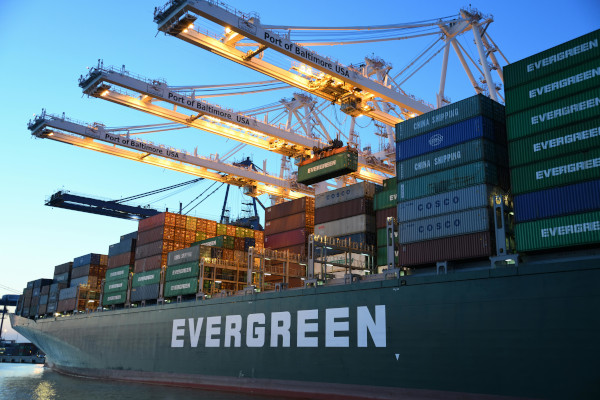In the early hours of Monday, March 26, the MV Dali container ship lost power and collided with the Francis Scott Key Bridge in Baltimore, Maryland, causing it to collapse. Just a few days later, Taiwan’s strongest earthquake in decades occurred off the country’s east coast, triggering massive landslides.
 The most devastating impact of these disasters is the loss of human life. As public institutions and rescue workers work valiantly to save lives and continue rescue and recovery efforts in the aftermath of these catastrophes, there is simultaneously an effort to ease the supply chain impact—with both immediate ripple effects, and latent as recovery continues. The port of Baltimore supports more than 15,000 jobs and handled more than 52 million tons of international cargo in 2023—worth about $80.8 billion, according to the state of Maryland’s records. In Taiwan, semiconductor manufacturers evacuated facilities before resuming operations, highlighting potential wide-ranging challenges should a worse disaster occur.
The most devastating impact of these disasters is the loss of human life. As public institutions and rescue workers work valiantly to save lives and continue rescue and recovery efforts in the aftermath of these catastrophes, there is simultaneously an effort to ease the supply chain impact—with both immediate ripple effects, and latent as recovery continues. The port of Baltimore supports more than 15,000 jobs and handled more than 52 million tons of international cargo in 2023—worth about $80.8 billion, according to the state of Maryland’s records. In Taiwan, semiconductor manufacturers evacuated facilities before resuming operations, highlighting potential wide-ranging challenges should a worse disaster occur.
Now, as recovery efforts for both events continue, an already stretched global supply chain will have to navigate the effects of what could be lasting repercussions. These moments shine a light on how critical it is for companies to ensure they have nimble and flexible operations to help them quickly respond and mitigate unanticipated events.
The fragility of our global supply chains has been underscored again by unexpected tragedies and natural disasters, from COVID-19 to Russia’s invasion of Ukraine. With similar events potentially on the horizon, the process of supply chain recovery can feel continual. Yet, companies must take steps now to make their supply chain more resilient, aiding in future-proofing a business built for growth.
In these moments of crisis, buyers and suppliers want instant updates on the location of products, while logistics providers need the status of and ability to re-route shipments amid any issues. Here’s how supply chain leaders and practitioners can tap into technology to drive resilience in the face of future disruptions.
Increase visibility through technology
After the Francis Scott Key Bridge collapsed, the Port of Baltimore was closed, and global shippers and logistics providers saw delays for customers at every level of the supply chain. At this point, suppliers’ primary focus is to ensure orders reach their destination by committed delivery dates, or they can relay new delivery dates to maintain realistic expectations. Concurrently, buyers are focused on the continuity of supply to keep operations running to meet production schedules.
Having a clear understanding of inventory and shipment statuses in normal circumstances, let alone a disaster situation like this, is a challenge for even the most sophisticated organizations. In many cases, they lack the real-time awareness or digital tools to collaborate on the best response.
To navigate the recovery curve in Baltimore and Taiwan, companies must leverage the right technology to achieve real-time visibility, optimized operations, and two-way collaboration with ecosystem partners. It’s imperative that they utilize business networks concentrated on increasing communication and transparency. These platforms allow businesses to collaborate with other companies across various domains, including procurement, supply chain management, human resources, and asset management.
Real-time shipment data, which feeds into collaborative technology, can track and present updates about impacted customer orders. Without detailed information, procurement and fulfillment teams would discover the impact of the incidents with no time to respond. Armed with accurate insights, manufacturers and suppliers can identify and mitigate risks or plan against their forecasts. If issues are identified along the way, companies can use their supply chain software to replan, and business network software to connect with partners to make necessary adjustments.
These technologies can help organizations evolve from being allocation-dependent to responsive and demand-driven. Such a shift in thinking and acting could create additional lead time to secure alternate supply, develop other production plans, or inform customers of delays to maintain a competitive advantage in times of adversity.
Identify alternative solutions
Supply chain success is built on the finest of margins. A small issue far up the line could have a surprisingly big impact elsewhere.
Companies must be relaying information across the supply chain to recognize risks and opportunities for adjustment. Having early knowledge of events, like in Maryland or Taiwan, through up-to-the-minute data gives companies time for proactive management.
Modern business network platforms allow cross-company stakeholders to gather an image of key processes and critical equipment, using AI and machine learning to exert more control over supply chains. The real-time visibility made possible through these technologies can help re-route shipments and, if necessary, identify alternate suppliers. The time savings found in these processes mean organizations can maneuver resources, reduce time spent on error resolution, and even plan logistics staffing based on delivery times.
The assurance provided by shared information on a collaborative platform means that companies can navigate uncertain situations with greater confidence. For companies experiencing the effects of current disasters, investing in technology like real-time track and trace solutions can enable proactive, data-driven decision-making, such as determining alternative shipping routes, accurate estimates, and the ability to provide reliable updates to the customer to help ease concerns over delivery timing.
The organizations whose purchases were scheduled to move through Baltimore or Taiwan need to identify rapid solutions to ease customer concerns and ensure that costs do not rise to exorbitant amounts. Crises like these are never simple to navigate, but doing so without the aid of technology will lead to further delays and anxiety.
Navigate and collaborate with extensive networks
In previous years, we’ve seen more environmental events like the Texas Freeze, Hurricane Ida, the Canadian forest fires, and many more impact global supply chains. Make no mistake, it can be challenging to partner with various suppliers across different business units, geographies, and needs during these crises.
For instance, it may take weeks for Taiwanese semiconductors to reach gaming or computing factories, impacting the delivery dates to their customers. As many companies turn to outsourcing as a primary means of production, easing the risks and disruptions of a widespread manufacturing network has become a challenge. These disruptions can sometimes cause businesses to not receive the raw materials or finished goods, or semiconductors in this instance.
Reliance on yesterday’s manual tools only makes it even more difficult for companies to respond to unexpected events or avoid them. An SAP survey in collaboration with Oxford Economics found that a concerning percentage of executives still use manual means or outdated technologies to do so: 32% report using phone, e-mail, and spreadsheets as their primary means of collaboration with external partners on key supply chain processes.
When an incident like the Francis Scott Key bridge collapse occurred, the effectiveness of manual tools went out the window. This makes it nearly impossible to maintain a single, integrated source of truth—illustrating why it’s so crucial to digitize purchase orders, freight information, shipment tracking, and invoices across trading partners.
Modern, collaborative technology focused on digitally connecting organizations across the supply chain can help buyers identify sellers who have replacement products within their parameters. This platform can also help suppliers promote goods or services, so buyers can find them during times of disruption and normal periods.
The fragility of our global supply chains has been underscored again by unexpected tragedies and natural disasters, from COVID-19 to Russia’s invasion of Ukraine. With similar events potentially on the horizon, the process of supply chain recovery can feel continual. Yet, companies must take steps now to make their supply chain more resilient, aiding in future-proofing a business built for growth.
With the help of digital tools and a collaborative business network, they can home in on potential impacts from unavoidable disruptions, have key information at their fingertips, and ensure all stakeholders are prepared for whatever comes next.
About the author:
Tony Harris is senior vice president and chief marketing and solutions officer for SAP Business Network.
SC
MR


More Risk Mitigation
- Rest assured: Building resilience in supply chains one mattress at a time
- Calculating financial business risk to identify supply chain vulnerabilities
- Predicting the future is impossible; so focus on mitigating risk and building resiliency
- Navigating global elections: A blueprint for supply chain resilience
- Moody’s weighs in on insurance risks supply chains face today
- More Risk Mitigation
What's Related in Risk Mitigation

 Explore
Explore
Topics
Business Management News
- U.S.-bound containerized import shipments are up in June and first half of 2024
- Expand supply chain metrics to cover the complete customer experience
- When disaster strikes, the supply chain becomes the key to life
- Leadership development for supply chain leaders
- A smarter approach to sustainability is vital for healthy, resilient supply chains
- When the scales tilt: Making vaccine access work for all
- More Business Management
Latest Business Management Resources

Subscribe

Supply Chain Management Review delivers the best industry content.

Editors’ Picks




